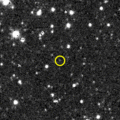Pasiphaë (moon) facts for kids
 |
|
| Discovery | |
|---|---|
| Discovered by | P. J. Melotte |
| Discovery date | January 27, 1908 |
| Orbital characteristics | |
| Periapsis | 16,980,250 km |
| Apoapsis | 31,209,300 km |
|
Mean orbit radius
|
24,094,770 km |
| Eccentricity | 0.2953 |
| 764.082032 d (2.092 a) | |
|
Average orbital speed
|
2.242 km/s |
| Inclination | 145.24° (to the ecliptic) 143.04° (to Jupiter's equator) |
| Satellite of | Jupiter |
| Physical characteristics | |
|
Mean radius
|
20 km 18 km |
| ~11,300 km² | |
| Volume | ~113,000 km³ |
| Mass | 3.0×1017 kg |
|
Mean density
|
2.6 g/cm³ (assumed) |
| ~0.022 m/s2 (0.002 g) | |
| ~0.036 km/s | |
| Albedo | 0.04 (assumed) 0.10 |
| Temperature | ~124 K |
Pasiphae is one of Jupiter's many moons. It is a small, rocky world orbiting far from the giant planet. Scientists believe it might be a piece of a larger object that broke apart long ago.
This moon was discovered in 1908 by an astronomer named Philibert Jacques Melotte. It was later named after Pasiphaë, a figure from Greek mythology. In these ancient stories, Pasiphaë was the wife of King Minos and the mother of the Minotaur.
Contents
What is Pasiphae?
Pasiphae is an irregular satellite of Jupiter. This means it has a very unusual orbit. Unlike most moons, it does not orbit in the same direction as Jupiter spins. Instead, it moves in the opposite direction, which is called a retrograde orbit.
How Big is Pasiphae?
Pasiphae is quite small compared to Earth's Moon. Its average radius is about 20 kilometers (12 miles). This makes it one of Jupiter's smaller moons. Its surface area is roughly 11,300 square kilometers.
Pasiphae's Orbit Around Jupiter
Pasiphae orbits Jupiter at a very long distance. Its average distance from Jupiter is about 24 million kilometers. It takes Pasiphae about 764 Earth days, or just over two Earth years, to complete one orbit around Jupiter. Its path around Jupiter is also not a perfect circle; it is quite elliptical.
The Pasiphae Group
Pasiphae is the largest member of a group of moons known as the Pasiphae group. These moons all share similar orbits. They are thought to have come from a single larger asteroid. This asteroid likely broke apart after a collision.
Other Moons in the Group
Other moons in the Pasiphae group include Sinope, Callirrhoe, and Megaclite. All these moons are also small and have retrograde orbits. Studying them helps scientists understand the early solar system.
Images for kids
See also
 In Spanish: Pasífae (satélite) para niños
In Spanish: Pasífae (satélite) para niños


